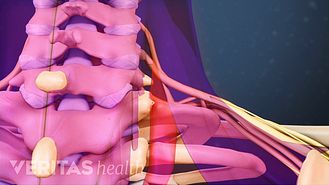Chronic neck pain can range from an achy annoyance to shock-like pain that goes into the arm and becomes debilitating. Neck pain is typically classified as chronic when it persists or regularly recurs for at least 3 months.
Video: Neck Pain Causes
Learn about the common issues and conditions that can cause acute and chronic neck pain. Watch Now
Outlined below are potential causes of chronic neck pain.
Cervical Spondylosis
Cervical spondylosis is an umbrella term for spinal degeneration that occurs in the neck. Cervical spondylosis may include:
- Cervical degenerative disc disease. As the intervertebral discs lose hydration over time, they also lose height and become less flexible. This degenerative process could cause the disc to become painful and/or nearby nerves to become compressed.
- Cervical osteoarthritis. When a facet joint’s protective cartilage begins to wear away, bone starts grinding against bone. The joint may grow bone spurs (osteophytes) and become inflamed and painful.
- Cervical herniated disc. When part or all of the disc’s outer layer (annulus fibrosus) tears, jelly-like material from the inner layer (nucleus pulposus) leaks into the outer later. This leaking may cause inflammation and pain. When the tear is large, the inner layer’s inflammatory proteins may leak completely out of the disc and onto a nearby nerve root.
- Cervical foraminal stenosis. This condition involves the narrowing of the intervertebral foramen, the bony opening where the nerve root exits the spinal canal. This narrowing can be caused by disc degeneration, ligament thickening, and/or bone spurs. When a cervical nerve root becomes compressed, it can cause cervical radicular pain (arm pain) and/or cervical radiculopathy (arm numbness and/or weakness).
- Cervical central stenosis. This condition involves narrowing of the spinal canal within the neck. As with cervical foraminal stenosis, this condition can be caused by disc degeneration, ligament thickening, and/or bone spurs. When the spinal cord becomes compressed within the neck, it can cause pain and/or cervical myelopathy (numbness, weakness, and/or reflex problems) anywhere beneath the level of compression, such as in the arms or legs.
While spondylosis is typically due to wear-and-tear over time, this process may be accelerated by an injury.
In This Article:
- Chronic Neck Pain Causes
- How Does Severe Neck Pain Develop?
- Neck Pain Causes Video
Traumatic Injury
Excessive force from a collision or fall may damage the discs, joints, muscles, ligaments, bones, and/or other tissues in the neck. Common examples include:
- Auto collision (whiplash)
- Sports collision or fall, such as in football, hockey, or gymnastics
- Slip on ice or wet floor
- Fall from height, such as down steps or a ladder
While neck pain typically goes away after an acute injury has healed, sometimes the pain persists and becomes chronic.
Poor Posture (Forward Head Posture)
The cervical spine is in neutral position when the ears are directly over the shoulders with the chest open and shoulders back. When the head drifts forward, such as while slouched at a computer desk or looking down at a tablet, additional stress is placed on the cervical spine’s joints, discs, and muscles. One study found that for every inch of forward head posture, an additional 10 pounds of weight is felt on the cervical spine.1
See How Does Text Neck Cause Pain?
Lack of activity and poor posture has been correlated with chronic neck pain.2 It is also possible for forward head posture to exacerbate other conditions, such as degenerative disc disease and/or cervical osteoarthritis.
See How Poor Posture Causes Neck Pain
Uncommon Causes of Chronic Neck Pain
Less common causes of chronic neck pain may include:
- Fibromyalgia. While difficult to diagnose, fibromyalgia typically includes widespread pain, tenderness, and fatigue. Tender points associated with fibromyalgia are commonly found in the neck and upper back.
- Cervical myofascial pain syndrome. This condition involves achy muscles and connective tissues (myofascial tissues). Trigger points are likely to develop in the neck. When touched, a trigger point in the neck can flare up and refer pain to the head or upper back.
See Myofascial Therapy for the Treatment of Acute and Chronic Pain
- Spondylolisthesis. This condition occurs when a vertebra slips over the vertebra beneath it. Spondylolisthesis can be caused by vertebral fracture, ligament laxity, and/or advanced disc degeneration.
Various other rare causes of chronic neck pain exist, such as spinal tumors or infection.
Read more about Neck Pain Causes
Chronic Neck Pain Can Be Complex
Multiple factors may be involved in chronic neck pain, and these factors can vary from person to person. For example, research indicates that chronic neck pain is more common in people who have anxiety, depression, or other mental health issues.3 While the reason is unknown, it may be related to various types of ongoing stress, such as social isolation or financial struggles.4 It is also possible that people who are prone to anxiety and/or depression perceive pain differently.
The underlying cause of neck pain is not always possible to identify. When a doctor performs a thorough medical examination but is unable to diagnose the source of neck pain, it is unlikely that the pain is due to a serious or life-threatening cause. In such instances, the pain is still real and a pain management program is still important.
Referrence
- 1.Kapandji IA. The Physiology of the Joints, Volume III. 6th ed. London: Churchill Livingstone; 2007.
- 2.Falla D, Jull G, Russell T, Vicenzino B, Hodges P. Effect of neck exercise on sitting posture in patients with chronic neck pain. Phys Ther. 2007; 87(4): 408-17.
- 3.Rees CS, Smith AJ, O’Sullivan PB, Kendall GE, Straker LM. Back and neck pain are related to mental health problems in adolescence. BMC Public Health. 2011; 11: 382. doi: 10.1186/1471-2458-11-382.
- 4.Yang H, Hitchcock E, Haldeman S et al. Workplace psychosocial and organizational factors for neck pain in workers in the United States. Am J Ind Med. 2016; 59(7):549-60. doi: 10.1002/ajim.22602.

